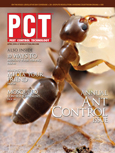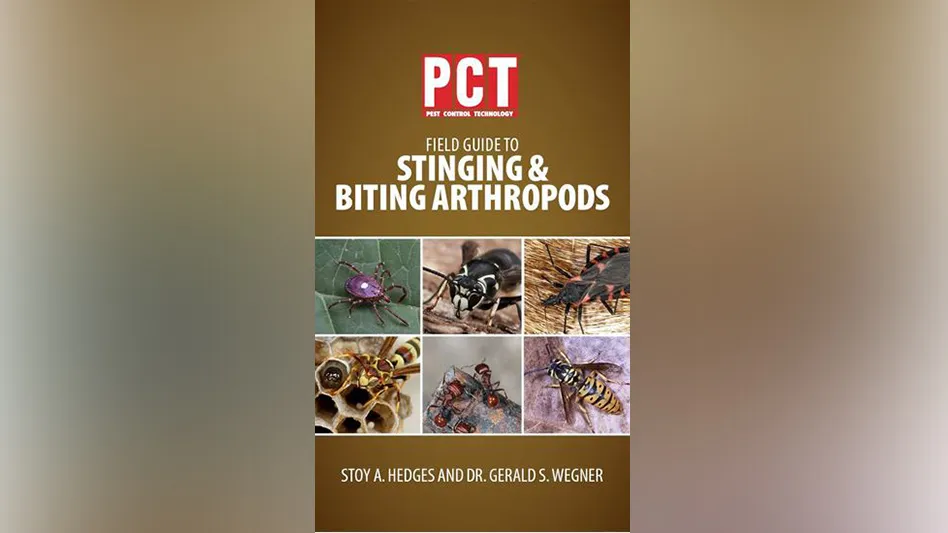There are at least 13 species of mites associated with house dust, but the American house dust mite, Dermatophagoides farinae, and European house dust mite, D. pteronyssinus (both in the mite family Pyroglyphidae) are the dominant mite species occurring in human dwellings. Dust mites are tiny, clear-to-tan colored arthropods covered with numerous setae (see photo left and Figure 1 on page 94) which are barely visible to the naked eye. One scientific paper characterized dust mites as the most important group of arthropods producing allergens contained in house dust in human habitations worldwide.1 They are medically important not because of bites or stings, but because of allergic reactions resulting from skin exposure or inhaling their body parts and feces. Mite allergens may sensitize people and induce perennial rhinitis (year-round stuffy nose), asthma, and/or atopic dermatitis (rashes) in a large number of humans with allergies every year. The allergens of dust mites are primarily found in their feces and, upon becoming airborne, can lead to the allergic symptoms described above.2 The common names of house dust mites (American and European) are misleading since both species of dust mites may occur in a home. For example, a four-year study of bedroom and family room carpets and couches in 252 homes widely scattered in the U.S. showed that most homes (81.7%) were cohabited by both dust mite species.3
DISTRIBUTION. House dust mites are widely distributed in many diverse climatic and home habitats where they feed upon shed human and animal dander as well as mold, fungal spores, pollen grains, and feathers. As mentioned, they do not bite. Their populations are highest in mattresses and overstuffed furniture frequently occupied by humans. Dust mites obtain water from the air; therefore they are dependent upon high humidity, being unable to thrive in relative humidity much less than 60%. This is an important factor relating to their control. In the northern temperate climate, their populations fluctuate directly with seasonal indoor relative humidity; they have high populations in spring, summer, and fall, and low populations during the winter heating season when indoor relative humidity is normally lower. This is true even if humidifiers are in use during the heating season simply because humidifiers are designed to maintain a relative humidity of about 35%.
WHAT TO DO ABOUT ’EM. Pest control professionals rarely have anything to do with dust mite control and allergen mitigation, other than perhaps offering air duct cleaning services which probably have a minimal impact on dust mite control. One preliminary study showed little dust mite allergen present in dust collected from intake and return vent filters,4 so air ducts themselves are not a major source of the problem. However, pest control personnel certainly may be questioned about dust mites and their control during the course of their work and should know something about the microscopic creatures for that reason.
Interventions intended to reduce dust mites in bedrooms or homes actually work. A dust-free bedroom diminishes asthma in children who have house dust mite allergy.5 Most interventions for house dust mites have three goals: 1) reduce mite populations, 2) reduce the mite allergen levels, and 3) reduce human exposure to both mites and their allergens. Perhaps the most important way to reduce dust mites is to lower indoor relative humidity (RH) since ambient RH is the key factor that influences dust mite population numbers. This may involve the use of high-efficiency dehumidifiers. The goal is to maintain RH below 50%. Replacing carpets, draperies, and upholstery is also an effective way to reduce mite populations. In homes with a dust mite-allergic person, anything that is soft and made of fabric should be replaced with a hard surface alternative. Hardwood, tile, or linoleum floors can be substituted for carpets, and blinds or shades can be used instead of draperies and curtains. Vacuuming, washing, drying, and dry cleaning of bedding materials may also reduce mite numbers. Washing sheets, pillow cases, blankets, and mattress pads at least weekly on the hot water setting (130°F) kills mites and helps remove allergen. Studies have shown that even washing clothes on the cold cycle can reduce allergen concentration by more than 90%.6 But even the most zealous housekeeper can’t completely eliminate dust mite populations by washing and vacuuming. Research on the effects of vacuuming to reduce house dust mite populations has found that although a motorized vacuum cleaner nozzle removes great amounts of dust and dead mites, no significant effect is noted in reducing mite populations.7 Vacuum bags with double layers or HEPA filters will help prevent allergens from being aerosolized during the vacuuming process.8 However, even regular vacuuming does not eliminate deeply embedded allergens or completely rid the home of live mites.
*****
12 Reduction tips
Various ways your customers can reduce house dust mites and avoid their allergens:
- Encase pillows, mattress and the box springs in zippered, allergen-impermeable, dust-proof covers. Covers that permit perspiration vapor transmission will be most comfortable.
- All bedding — sheets, blankets, pillow cases, and mattress pads should be washed every week or two in hot water (130°F). If comforters are not encased in allergen- impermeable covers, they should also be washed every two weeks.
- Vacuum clean weekly (wear a mask and leave the room for 20 minutes after cleaning).
- Make sure the vacuum cleaner has a double-thickness bag or a HEPA filter on the air outlet.
- Carpeting should be removed from the room, and tile, wood, or other non-fibrous flooring should be installed.
- Use shades or blinds in windows instead of draperies or curtains.
- Avoid fabric-based wall decorations such as pennants, tapestries, and macrame hangings.
- Substitute wooden or plastic furniture for upholstered furniture, or choose vinyl or leather furniture that includes an additional allergen barrier.
- HEPA air purifiers will help further remove allergens in the air of the bedroom.
- Install allergen-trapping filters in air conditioning/heating systems.
- Keep all clothing in the closet with the door shut.
- Clean all drawers and dressers with a treated cloth, and wear a tight-fitting dust mask when performing household cleaning.
*****
Reducing human exposure to house dust allergens can be achieved by using mattress encasements. A major study in Australia showed that the use of impermeable mattress encasements helped lower dust mite allergen levels below the threshold for sensitization.9 Pillows and mattresses can be placed inside specifically manufactured protective coverings which are made from a variety of materials such as plastic, vapor-permeable materials, finely woven fabrics, or non-woven synthetics. Pore size is very important when considering encasements. Dust mite allergens are blocked below detectable levels by fabrics with a pore size of less than 10 µm, whereas the mites themselves would be blocked by pores < 20 µm.10
Acaricides have sometimes been used to reduce house dust mites in homes, but with mixed results. One study found that the use of benzyl benzoate resulted in reduction of floor carpet dust mite levels which persisted for three months,11 but another study showed that the product was not effective when applied according to the manufacturer’s instructions.12
Complete elimination of dust mites in a home is probably not possible, but tremendous reduction of their numbers can be achieved through a combination of the strategies listed above. Most of the efforts need to be focused in bedrooms due to the amount of time people spend there. Any one of these steps by itself will not provide complete allergy relief, so as many steps as possible should be completed. Even after encasement of mattresses, dust mites sometimes remain in pillows, bed coverings, and flooring material beneath and adjacent to the beds. As mentioned, treatment of heating and cooling ductwork is probably not successful nor appropriate as ducts are an unfavorable environment for the survival of dust mites anyway. Cleaning of the ducts to remove dust buildup, however, may be beneficial in improving overall air quality. As mentioned, dehumidifiers to keep humidity at low levels is probably the most helpful tool in keeping dust mite numbers low.
The author can be contacted via e-mail at
jgoddard@giemedia.com.
References cited:
- Lang JD, Mulla MS. Seasonal dynamics of house dust mites, Dermatophagoides spp., in homes in southern California. Environ. Entomol. 1978;7:281-286.
- Van Bronswijk JEHM. House Dust Biology. Zeist, Netherlands: NIB Publishers; 1981.
- Arlian LG, Dippold J. Development and fecundity of Dermatophagoides farinae. J. Med. Ent. 1996;32:257-260.
- Tsay A, Roman MC, Chapman EL, Chapman MD. Air duct cleaning to reduce allergen levels in the home – is it worthwhile? J. Allergy Clin. Immunol. (Abstract). 2000;105:S-271.
- Murray AB, Ferguson AC. Dust-free bedrooms in the treatment of asthmatic children with house dust or house dust mite allergy: a controlled trial. Pediatrics. 1983;71:418-422.
- McDonald LG, Tovey ER. The role of water temperature and laundry procedures in reducing house dust mite populations and allergen content of bedding. J. Allergy Clin. Immunol. 1992;90:599-608.
- Wassenaar DPJ. Reducing house dust mites by vacuuming. Exp. Appl. Acarol. 1988;4:167-171.
- Vaughan JW, Woodfolk JA, Platts-Mills TA. Assessment of vacuum cleaners and vacuum cleaner bags recommended for allergic subjects. J. Allergy Clin. Immunol. 1999;104:1079-1083.
- Hill DJ, Thompson PJ, Stewart GA, et al. The Melbourne house dust mite study: eliminating house dust mites in the domestic environment. J. Allergy Clin. Immunol. 1997;99:323-329.
- Vaughan JW, McLaughlin TE, Perzanowski MS, Platss-Mills TAE. Evaluation of materials used for bedding encasement: effect of pore size in blocking cat and dust mite allergen. J. Allergy Clin. Immunol. 1999;103:227-231.
- Chang JH, Becker A, Ferguson A, et al. Effect of application of benzyl benzoate on house dust mite allergen levels. Ann. Allergy Asthma Immunol. 1996;77:187-190.
- Huss RW, Huss K, Squire EN, Jr., et al. Mite allergen control with acaricide fails. J. Allergy Clin. Immunol. 1994;94:27-32.

Explore the April 2010 Issue
Check out more from this issue and find you next story to read.
Latest from Pest Control Technology
- Gaining Control of Structure-Infesting Carpenter Ants
- Big Blue Bug’s Brian Goldman Receives Rhode Island Small Business Person of the Year Award
- UF Researchers Examine How Much Bait it Takes to Eliminate a Subterranean Termite Colony
- Women in Pest Control Group Continues to Grow, Provide Opportunities in the Industry
- NPMA Announces Results of 2024-2025 Board of Directors Election
- Massey Services Acquires Orange Environmental Services
- Hawx Pest Control Wins Bronze Stevie Award for Sustainability
- Abell Pest Control Highlights Growing Tick Activity Across Canada





